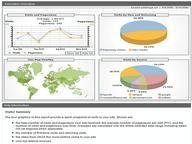Quiz Answer Key and Fun Facts
1. There is a carnival game that requires you to roll two standard 6-sided dice. If the sum of the dice rolls is a prime number, then you win. What is the probability of winning?
2. There is a standard 52-card deck. If you draw three cards randomly, without placing each back in the deck, what is the probability that all three cards are spades?
3. A box contains one of each of the bills: $1, $5, $10, $20, $50, and $100. If you randomly draw three bills, then what are the odds that the three bills add to $75?
4. You are running from 3 police officers and there are 5 possible caves to hide in. You hide in a random cave before the officers see you. Each of the officers chooses a random cave to search. More than one officer can search the same cave. If there is a 100% chance a cop will find you if he searches your cave, then what are the odds you will be found?
5. You randomly draw 3 cards from a standard 52-card deck. What are the odds that you draw 3 different suits?
6. A casino game costs $5 to play where you roll two dice. If the sum of the dice rolls is 7, you receive $21 (but not your bet back). If the sum of the dice rolls is not 7, then you lose and get nothing. If you keep playing and stop when you win, what are the odds you will have made money?
7. There is a box containing blue, red, yellow, and green pencils. You randomly draw one of the 50 pencils. You are 2.3 times more likely to draw a green pencil than you are to draw a blue pencil. There are 8 more green pencils than there are red pencils. If you have a 4% chance of drawing a yellow pencil, then what are the odds of drawing a red pencil?
8. You draw two random cards from a standard 52-card deck. What is the probability that you will draw at least one ace?
9. You randomly flip four coins. What is the probability that you will get 2 heads and 2 tails?
10. You randomly roll two dice. What is the probability that the product of the two numbers rolled will equal a square number?
Source: Author
iggy4
This quiz was reviewed by FunTrivia editor
crisw before going online.
Any errors found in FunTrivia content are routinely corrected through our feedback system.


